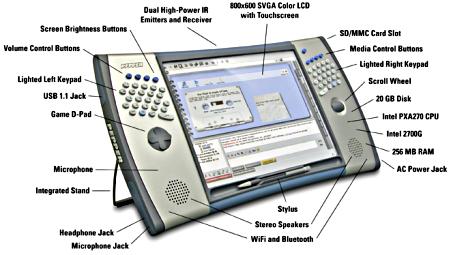Device profile: Pepper Pad 2 wireless webpad
Sep 8, 2004 — by LinuxDevices Staff — from the LinuxDevices Archive — 7 viewsPepper Computer has revised its simplified Linux-based wireless webpad for digital homes, and will offer the device direct to consumers. The Pepper Pad is intended to provide basic digital home computing functions, including web browsing, email, IM, and collecting and organizing photos, music, and videos. It also includes writing and editing software and a variety of games.

The Pepper Pad 2 has a horizontal screen orientation
(Click to enlarge)
Pepper launched its first-generation Pepper Pad as a reference design for broadband providers in December of 2003. It will continue to market the original Pad mainly to Internet service providers, but will also offer the second-generation Pepper Pad direct to consumers.
In comparison to the original Pad, the Pepper Pad 2 has a landscape screen orientation, and a more powerful CPU and graphics co-processor. The new version will be built by Taiwanese manufacturer LiteOn, and will be available direct from Pepper late in 2005 for $800.
Hardware
The second-generation Pepper Pad has a 8.4-inch 800×600 TFT LCD touchscreen display, in landscape orientation (the first-generation Pepper Pad uses a portrait orientation). The device has a split QWERTY keyboard, and also includes a Bluetooth radio supporting wireless keyboards and input devices, as well as top-mounted dual IrDA emitters and an IR receiver.

The Pepper Pad 2
(Click to enlarge)
The Pepper Pad uses Intel's newest high performance, low-power XScale chip optimized for wireless mobile devices, the ARM-based PXA270 (formerly “Bulverde”), clocked at 624 MHz. The Pad also uses Intel's 2700G “multimedia accelerator” chip, said to enable full-screen video at full-frame rates without sacrificing battery life.
The Pad boots from 32MB of Intel StrataFlash, and comes with 256MB of SDRAM. It also comes with a tiny internal hard drive, a 1.8-inch (PCMCIA sized) ATA drive with a 20GB capacity, and an external SD/MMC memory card slot.
The Pad has a 20-bit stereo sound system with integrated stereo speakers, microphone, and analog audio I/O ports.
Additional I/O interfaces include 802.11b+g WiFi LAN, a USB 1.1 host port, and power jack. The device includes two integral 3400mAh Li-Polymer batteries, and comes with a 5V/3A AC power adapter. The Pepper Pad weighs 2.3 lbs (1043 grams), and measures 12.1 x 6.6 x 0.8 inches (309 x 175 x 20mm).
Software
The new Pepper Pad runs MontaVista Linux Consumer Electronics Edition (CEE) 3.1, which is based on a 2.4.20 Linux kernel. It also includes a Java 2 environment, along with “Pepper Keeper,” a Java application said to help users manage their digital file collections. Pepper Keeper is also available separately, direct from Pepper, for a wide range of platforms.
Various Pepper Keeper plugins are available separately, and allow “self-organizing collections” for digital photos, music, videos, email, web clippings, and addresses, according to Pepper. Plugins are also available for photo albums, scrapbooks, MP3 mixtapes, journals, notebooks, and greeting cards.
“The Pepper Pad was designed for the world consumers live in today, for use in the Digital Home or on-the-go. As music, photos, and videos become as much a part of daily life as email, IM, and the Web, consumers — in the US and worldwide — want them all accessible in a convenient way,” said Len Kawell, CEO of Pepper.
Pepper is currently accepting online pre-orders for the $800 Pepper Pad 2. It expects to have limited quantities available this year, with unspecified retailers picking up the device in 2005. Its primary distribution channel will comprise broadband distributors bundling the Pepper Pad with Internet services, however.
This article was originally published on LinuxDevices.com and has been donated to the open source community by QuinStreet Inc. Please visit LinuxToday.com for up-to-date news and articles about Linux and open source.